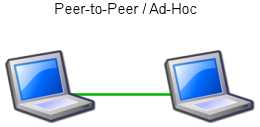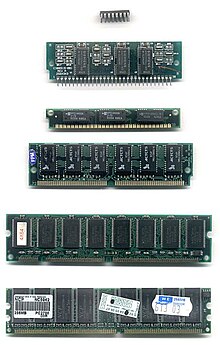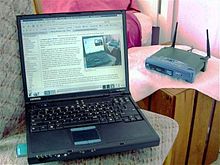
An example of a Wi-Fi network.
A
wireless local area network (
WLAN) links two or more devices using some wireless distribution method (typically
spread-spectrum or
OFDM
radio), and usually providing a connection through an access point to
the wider internet. This gives users the mobility to move around within a
local coverage area and still be connected to the network. Most modern
WLANs are based on
IEEE 802.11 standards, marketed under the
Wi-Fi brand name.
Wireless LANs have become popular in the home due to ease of
installation, and in commercial complexes offering wireless access to
their customers; often for free. Large wireless network projects are
being put up in many major cities:
New York City, for instance, has begun a pilot program to provide city workers in all five boroughs of the city with wireless
Internet access.
[1]
History
Norman Abramson, a professor at the
University of Hawaii, developed the world’s first wireless computer communication network,
ALOHAnet,
using low-cost ham-like radios. The system included seven computers
deployed over four islands to communicate with the central computer on
the Oahu Island without using phone lines.
[2]
"In 1979, F.R. Gfeller and U. Bapst published a paper in the IEEE Proceedings reporting an experimental wireless local area network using diffused infrared communications. Shortly thereafter, in 1980, P. Ferrert reported on an experimental application of a single code spread spectrum
radio for wireless terminal communications in the IEEE National
Telecommunications Conference. In 1984, a comparison between infrared
and CDMA spread spectrum communications for wireless office information
networks was published by Kaveh Pahlavan
in IEEE Computer Networking Symposium which appeared later in the IEEE
Communication Society Magazine. In May 1985, the efforts of Marcus led
the FCC to announce experimental ISM bands
for commercial application of spread spectrum technology. Later on, M.
Kavehrad reported on an experimental wireless PBX system using code
division multiple access. These efforts prompted significant industrial
activities in the development of a new generation of wireless local area
networks and it updated several old discussions in the portable and
mobile radio industry.
The first generation of wireless data modems was developed in the
early 1980's by amateur communication groups. They added a voice band
data communication modem, with data rates below 9600 bps, to an existing
short distance radio system such as a walkie talkie. The second
generation of wireless modems was developed immediately after the FCC
announcement in the experimental bands for non-military use of the
spread spectrum technology. These modems provided data rates on the
order of hundreds of Kbps. The third generation of wireless modem now
aims at compatibility with the existing LANs with data rates on the
order of Mbps. Currently, several companies are developing the third
generation products with data rates above 1 Mbps and a couple of
products have already been announced. "[3]

54 Mbit/s WLAN PCI Card (802.11g)
"The first of the IEEE Workshops on Wireless LAN was held in 1991. At that time early wireless LAN products had just appeared in the market and the IEEE 802.11
committee had just started its activities to develop a standard for
wireless LANs. The focus of that first workshop was evaluation of the
alternative technologies. By 1996, the technology was relatively mature,
a variety of applications had been identified and addressed and
technologies that enable these applications were well understood. Chip
sets aimed at wireless LAN implementations and applications, a key
enabling technology for rapid market growth, were emerging in the
market. Wireless LANs were being used in hospitals, stock exchanges, and
other in building and campus settings for nomadic access,
point-to-point LAN bridges, ad-hoc networking,
and even larger applications through internetworking. The IEEE 802.11
standard and variants and alternatives, such as the wireless LAN
interoperability forum and the European HiperLAN specification had made rapid progress, and the unlicensed PCS Unlicensed Personal Communications Services and the proposed SUPERNet, later on renamed as U-NII, bands also presented new opportunities."[4]
WLAN hardware was initially so expensive that it was only used as an
alternative to cabled LAN in places where cabling was difficult or
impossible. Early development included industry-specific solutions and
proprietary protocols, but at the end of the 1990s these were replaced
by standards, primarily the various versions of IEEE 802.11 (in products
using the
Wi-Fi brand name). An alternative
ATM-like 5 GHz standardized technology,
HiperLAN/2, has so far not succeeded in the market, and with the release of the faster 54 Mbit/s
802.11a (5 GHz) and
802.11g
(2.4 GHz) standards, it is even more unlikely that it will ever
succeed. Since 2002 there has been newer standard added to 802.11;
802.11n which operates on both the 5Ghz and 2.4Ghz bands at 300 Mbit/s,
most newer routers can broadcast a wireless network on both wireless
bands, this is called dualband. Because of the crowded 2.4Ghz band and
the interference with other services like Bluetooth, more and more
routers are available as dualband version. The extension of the 5Ghz to
5.8Ghz leaves space for a lot of more stations. A
HomeRF group was formed in 1997 to promote a technology aimed for residential use, but disbanded at the end of 2002.
[5]
Architecture
Stations
All components that can connect into a wireless medium in a
network are referred to as stations. All stations are equipped with
wireless network interface controllers (WNICs). Wireless stations fall into one of two categories:
access points, and clients. Access points (APs), normally
routers,
are base stations for the wireless network. They transmit and receive
radio frequencies for wireless enabled devices to communicate with.
Wireless clients can be mobile devices such as laptops,
personal digital assistants,
IP phones and other
smartphones, or fixed devices such as
desktops and
workstations that are equipped with a wireless network interface.
Basic service set
The basic service set (BSS) is a set of all stations that can
communicate with each other. Every BSS has an identification (ID) called
the BSSID, which is the
MAC address of the access point servicing the BSS.
There are two types of BSS: Independent BSS (also referred to as IBSS), and infrastructure BSS. An independent BSS (IBSS) is an
ad-hoc network that contains no access points, which means they can not connect to any other basic service set.
Extended service set
An extended service set (ESS) is a set of connected BSSs. Access
points in an ESS are connected by a distribution system. Each ESS has an
ID called the SSID which is a 32-byte (maximum) character string.
Distribution system
A distribution system (DS) connects access points in an extended
service set. The concept of a DS can be used to increase network
coverage through roaming between cells.
DS can be wired or wireless. Current wireless distribution systems
are mostly based on WDS or MESH protocols, though other systems are in
use.
Types of wireless LANs
Peer-to-peer

Peer-to-Peer or ad-hoc wireless LAN
An ad-hoc network also called
WiFi Direct network
is a network where stations communicate only peer to peer (P2P). There
is no base and no one gives permission to talk. This is accomplished
using the Independent Basic Service Set (IBSS).
In a Wi-Fi P2P group the group owner operates as an access point and
all other devices are clients. There are two main methods to establish a
group owner in the Wi-Fi Direct group. In one approach user sets up a
P2P group owner manually. This method is also known as Autonomous Group
Owner (autonomous GO). In the second method also called
negotiation-based group creation two devices compete based on the group
owner intent value. The device with higher intent value becomes a group
owner and the second device becomes a client. Group owner intent value
can depend on whether the wireless device performs a cross-connection
between an infrastructure WLAN service and a P2P group, remaining power
in the wireless device, whether the wireless device is already a group
owner in another group and/or a received signal strength of the first
wireless device.
A
peer-to-peer
(P2P) network allows wireless devices to directly communicate with each
other. Wireless devices within range of each other can discover and
communicate directly without involving central access points. This
method is typically used by two computers so that they can connect to
each other to form a network.
If a signal strength meter is used in this situation, it may not read
the strength accurately and can be misleading, because it registers the
strength of the strongest signal, which may be the closest computer.

Hidden node problem: Devices A and C are both communicating with B, but are unaware of each other
IEEE 802.11 defines the physical layer (PHY) and MAC (Media Access Control) layers based on
CSMA/CA
(Carrier Sense Multiple Access with Collision Avoidance). The 802.11
specification includes provisions designed to minimize collisions,
because two mobile units may both be in range of a common access point,
but out of range of each other.
The 802.11 has two basic modes of operation: ad hoc mode and
infrastructure mode. In ad hoc mode, mobile units transmit directly
peer-to-peer. In infrastructure mode, mobile units communicate through
an access point that serves as a bridge to a wired network
infrastructure. Since wireless communication uses a more open medium for
communication in comparison to wired LANs, the 802.11 designers also
included shared-key encryption mechanisms:
Wired Equivalent Privacy (WEP),
Wi-Fi Protected Access (WPA, WPA2), to secure wireless computer networks.
Bridge
A bridge can be used to connect networks, typically of different types. A wireless
Ethernet
bridge allows the connection of devices on a wired Ethernet network to a
wireless network. The bridge acts as the connection point to the
Wireless LAN.
Wireless distribution system
A Wireless Distribution System enables the wireless interconnection
of access points in an IEEE 802.11 network. It allows a wireless network
to be expanded using multiple access points without the need for a
wired backbone to link them, as is traditionally required. The notable
advantage of WDS over other solutions is that it preserves the MAC
addresses of client packets across links between access points.
[6]
An access point can be either a main, relay or remote base station. A
main base station is typically connected to the wired Ethernet. A relay
base station relays data between remote base stations, wireless clients
or other relay stations to either a main or another relay base station.
A remote base station accepts connections from wireless clients and
passes them to relay or main stations. Connections between "clients" are
made using MAC addresses rather than by specifying IP assignments.
All base stations in a Wireless Distribution System must be
configured to use the same radio channel, and share WEP keys or WPA keys
if they are used. They can be configured to different service set
identifiers. WDS also requires that every base station be configured to
forward to others in the system as mentioned above.
WDS may also be referred to as repeater mode because it appears to
bridge and accept wireless clients at the same time (unlike traditional
bridging). It should be noted, however, that throughput in this method
is halved for all clients connected wirelessly.
When it is difficult to connect all of the access points in a network
by wires, it is also possible to put up access points as repeaters.
Roaming

Roaming among Wireless Local Area Networks
There are two definitions for wireless LAN roaming:
- Internal Roaming (1): The Mobile Station (MS) moves from one access
point (AP) to another AP within a home network because the signal
strength is too weak. An authentication server (RADIUS) presumes the
re-authentication of MS via 802.1x (e.g. with PEAP).
The billing of QoS is in the home network. A Mobile Station roaming
from one access point to another often interrupts the flow of data among
the Mobile Station and an application connected to the network. The
Mobile Station, for instance, periodically monitors the presence of
alternative access points (ones that will provide a better connection).
At some point, based on proprietary mechanisms, the Mobile Station
decides to re-associate with an access point having a stronger wireless
signal. The Mobile Station, however, may lose a connection with an
access point before associating with another access point. In order to
provide reliable connections with applications, the Mobile Station must
generally include software that provides session persistence.[7]
- External Roaming (2): The MS (client) moves into a WLAN of another
Wireless Internet Service Provider (WISP) and takes their services
(Hotspot). The user can independently of his home network use another
foreign network, if this is open for visitors. There must be special
authentication and billing systems for mobile services in a foreign
network.
References











